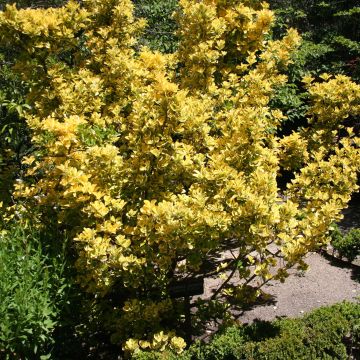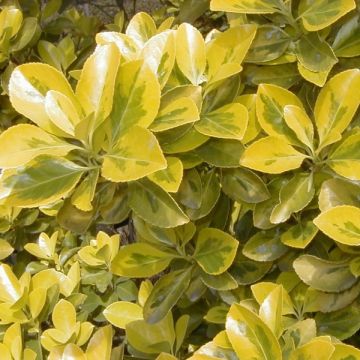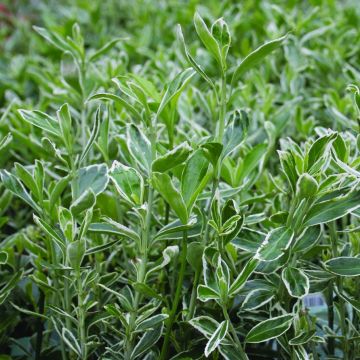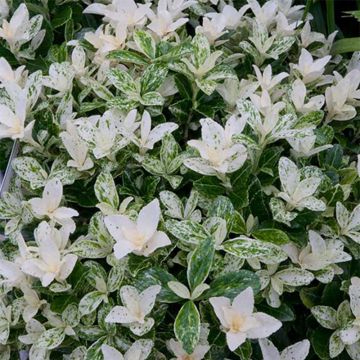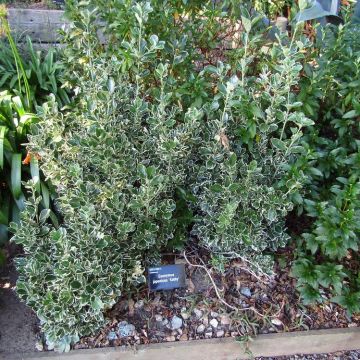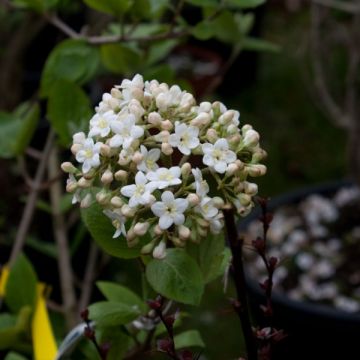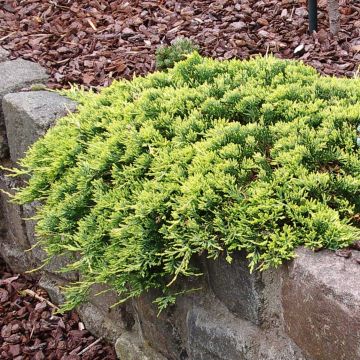

Euonymus japonicus Jean Hugues - Japanese Spindle
Euonymus japonicus Jean Hugues - Japanese Spindle
Euonymus japonicus Jean Hugues
Japanese Spindle, Evergreen Spindle
This item cannot be shipped to the selected country
Delivery charge from €5.90
More information
Schedule delivery date,
and select date in basket
This plant carries a 24 months recovery warranty
More information
We guarantee the quality of our plants for a full growing cycle, and will replace at our expense any plant that fails to recover under normal climatic and planting conditions.
From €5.90 for pickup delivery and €6.90 for home delivery
Express home delivery from €8.90.
Does this plant fit my garden?
Set up your Plantfit profile →
Description
The Euonymus japonicus 'Jean Hugues' is a variety of Japanese spindle that is revered for its resemblance to boxwood borders. It is a small, upright and dense bush, adorned with small dark green leaves throughout the year, decorated with young tender green shoots in spring. It is perfect for creating borders, mazes, or low hedges with a neat appearance. It will also look great in a nice pot on the terrace or balcony, trimmed as a topiary.
The Japanese spindle Jean Hugues belongs to the family of Celastraceae. Its ancestor, named Euonymus japonicus in Latin, is native, as its name suggests, to Japan. But it is also found in China and Korea. In nature, this large shrub grows on slopes, in open areas at the edge of forests, and even by the seaside where it can become a tree reaching 8 metres (26 feet 2 inches) in height. Its hardiness is around -7 to -10°C, and its growth is quite slow.
The 'Jean Hugues' cultivar is a dwarf form. It grows very slowly, has a dense, narrow and very low habit, and will not exceed 90 cm (35.4 in) in height (on average 75 cm (29.5 in)) and 30-40 cm (11.8-15.7 in) in width. Its habit is naturally upright, supported by vertical branches. Its branches bear a very dense foliage, composed of small glossy leaves, 2 to 4 cm (0.8 to 1.6 in) long, changing from light green-yellow when young to forest green when mature. The discreet flowering takes place in May-June, at the tip of the young shoots. Tiny white-greenish flowers with 4 petals are clustered together. They are pollinated by insects and are followed by small green fruits that turn pink and orange in autumn, hanging under the branches. The evergreen foliage can be burned by severe frosts.
Euonymus japonicus Jean Hugues is a good alternative to boxwood in a formal garden. It can also be planted in a rock garden, to highlight ground cover plants (such as aubrietas, silver or gold baskets) and spreading plants (Armeria, saxifrages, carnations, etc.). The Japanese spindle is a great addition to any garden. Its dark leaves and simple appearance complement all flowers and colourful foliage. It is perfect for use in coastal areas and urban gardens and is often planted as a hedge along pathways or property boundaries to offer protection from wind and prying eyes. It can also be grown in containers on terraces or balconies and responds well to pruning.
Report an error about the product description
Euonymus japonicus Jean Hugues - Japanese Spindle in pictures


Plant habit
Flowering
Foliage
Botanical data
Euonymus
japonicus
Jean Hugues
Celastraceae
Japanese Spindle, Evergreen Spindle
Cultivar or hybrid
Other Japanese Spindle Trees - Euonymus japonicus
Planting and care
Euonymus japonicus Jean Hugues is preferably planted in spring in any well-drained soil in a gently sunny or lightly shaded position. It prefers deep soils, rich in humus, remaining moist, and tolerates the presence of limestone. It does not tolerate severe frosts, and is hardy up to about -10°C for short periods. Hot and dry climates are not very suitable for this evergreen spindle tree, as it may be invaded by mealybugs and sooty mould. Pruning is well tolerated between April and May.
Attention: pruning too early in spring can be harmful to young tender shoots in case of late frosts. Similarly, frequent pruning can lead to the development of sooty mould, especially in very dry soil. Apply fertiliser twice a year, in early spring and autumn. In case of drought, water to keep the beautiful foliage. If the plant is grown in a pot, it is necessary to change the growing substrate once a year in spring and water it regularly. Protect your pot if severe frosts are forecasted (<-5°C).
Planting period
Intended location
Care
This item has not been reviewed yet - be the first to leave a review about it.
Evergreen shrubs
Haven't found what you were looking for?
Hardiness is the lowest winter temperature a plant can endure without suffering serious damage or even dying. However, hardiness is affected by location (a sheltered area, such as a patio), protection (winter cover) and soil type (hardiness is improved by well-drained soil).

Photo Sharing Terms & Conditions
In order to encourage gardeners to interact and share their experiences, Promesse de fleurs offers various media enabling content to be uploaded onto its Site - in particular via the ‘Photo sharing’ module.
The User agrees to refrain from:
- Posting any content that is illegal, prejudicial, insulting, racist, inciteful to hatred, revisionist, contrary to public decency, that infringes on privacy or on the privacy rights of third parties, in particular the publicity rights of persons and goods, intellectual property rights, or the right to privacy.
- Submitting content on behalf of a third party;
- Impersonate the identity of a third party and/or publish any personal information about a third party;
In general, the User undertakes to refrain from any unethical behaviour.
All Content (in particular text, comments, files, images, photos, videos, creative works, etc.), which may be subject to property or intellectual property rights, image or other private rights, shall remain the property of the User, subject to the limited rights granted by the terms of the licence granted by Promesse de fleurs as stated below. Users are at liberty to publish or not to publish such Content on the Site, notably via the ‘Photo Sharing’ facility, and accept that this Content shall be made public and freely accessible, notably on the Internet.
Users further acknowledge, undertake to have ,and guarantee that they hold all necessary rights and permissions to publish such material on the Site, in particular with regard to the legislation in force pertaining to any privacy, property, intellectual property, image, or contractual rights, or rights of any other nature. By publishing such Content on the Site, Users acknowledge accepting full liability as publishers of the Content within the meaning of the law, and grant Promesse de fleurs, free of charge, an inclusive, worldwide licence for the said Content for the entire duration of its publication, including all reproduction, representation, up/downloading, displaying, performing, transmission, and storage rights.
Users also grant permission for their name to be linked to the Content and accept that this link may not always be made available.
By engaging in posting material, Users consent to their Content becoming automatically accessible on the Internet, in particular on other sites and/or blogs and/or web pages of the Promesse de fleurs site, including in particular social pages and the Promesse de fleurs catalogue.
Users may secure the removal of entrusted content free of charge by issuing a simple request via our contact form.
The flowering period indicated on our website applies to countries and regions located in USDA zone 8 (France, the United Kingdom, Ireland, the Netherlands, etc.)
It will vary according to where you live:
- In zones 9 to 10 (Italy, Spain, Greece, etc.), flowering will occur about 2 to 4 weeks earlier.
- In zones 6 to 7 (Germany, Poland, Slovenia, and lower mountainous regions), flowering will be delayed by 2 to 3 weeks.
- In zone 5 (Central Europe, Scandinavia), blooming will be delayed by 3 to 5 weeks.
In temperate climates, pruning of spring-flowering shrubs (forsythia, spireas, etc.) should be done just after flowering.
Pruning of summer-flowering shrubs (Indian Lilac, Perovskia, etc.) can be done in winter or spring.
In cold regions as well as with frost-sensitive plants, avoid pruning too early when severe frosts may still occur.
The planting period indicated on our website applies to countries and regions located in USDA zone 8 (France, United Kingdom, Ireland, Netherlands).
It will vary according to where you live:
- In Mediterranean zones (Marseille, Madrid, Milan, etc.), autumn and winter are the best planting periods.
- In continental zones (Strasbourg, Munich, Vienna, etc.), delay planting by 2 to 3 weeks in spring and bring it forward by 2 to 4 weeks in autumn.
- In mountainous regions (the Alps, Pyrenees, Carpathians, etc.), it is best to plant in late spring (May-June) or late summer (August-September).
The harvesting period indicated on our website applies to countries and regions in USDA zone 8 (France, England, Ireland, the Netherlands).
In colder areas (Scandinavia, Poland, Austria...) fruit and vegetable harvests are likely to be delayed by 3-4 weeks.
In warmer areas (Italy, Spain, Greece, etc.), harvesting will probably take place earlier, depending on weather conditions.
The sowing periods indicated on our website apply to countries and regions within USDA Zone 8 (France, UK, Ireland, Netherlands).
In colder areas (Scandinavia, Poland, Austria...), delay any outdoor sowing by 3-4 weeks, or sow under glass.
In warmer climes (Italy, Spain, Greece, etc.), bring outdoor sowing forward by a few weeks.


































